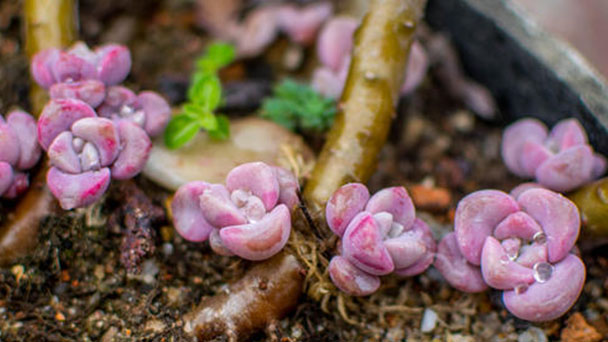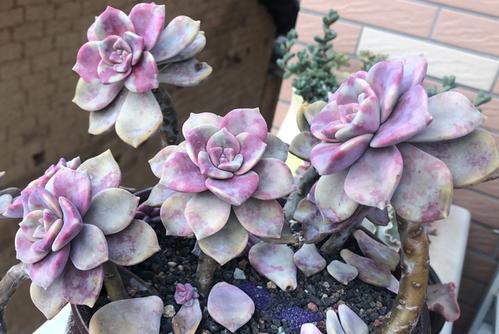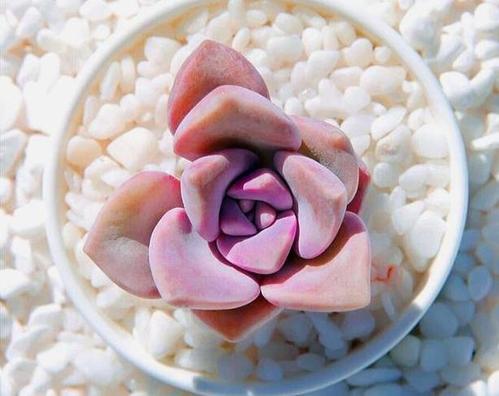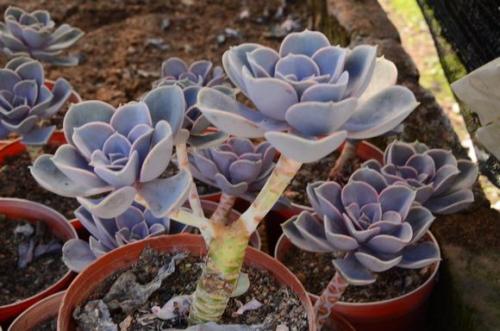How to Grow & Care for Graptopetalum Purple Delight in Summer
Written by Maggie
Dec 28 2022

Graptopetalum Purple Delight, also known as Graptopetalum Snow White, graptoveria purple delight, is a perennial succulent plant of The genus Graptopetalum. Graptopetalum Purple Delight is a hybrid variety and is popular as a potted succulent ornamental plant. In an environment with large temperature difference and abundant sunshine, the leaves gradually turn purple. The following will introduce the Graptopetalum Purple Delight care, grow, pruning and propagation tips.
Graptopetalum Purple Delight needs bright sunlight, good drainage, and infrequent water to prevent rot. Use well-draining cactus and succulent soil with 50% to 70% mineral grit, such as coarse sand, pumice, or perlite, and choose containers with drainage holes.
Graptopetalum Purple Delight info
| Botanical Name | Graptopetalum Purple Delight |
| Common Names | Graptopetalum Purple Delight |
| Plant Type | Succulent |
| BLOOM COLOR | White Bloom |
| Light | Full Sun, Bright Indoor Light |
| Cold hardiness | Zone 10 (30F) |
| Bloom color | White Bloom |
| Mature size | 9"-12" |
Graptopetalum Purple Delight Care and Growth in Summer
Be sure to get plenty of light, but be sure to provide shade protection during the summer when growing and care for Graptopetalum purple delight Succulent. Every time you water graptopetalum purple Delight succulent, you should do a good job of drainage during the rainy season. In summer, you should take cooling measures for graptopetalum Purple Delight. The highest temperature should not exceed 35℃. Every quarter, graptopetalum purple delight can be applied with the lung fluid after dilution to promote the growth of Graptopetalum Purple Delight succulent.

1. Graptopetalum Purple Delight Transitional Notes
August is an important period of transition cool from the heat in the summer to the cool in the autumn for Graptopetalum Purple Delight. Graptopetalum Purple Delight will slowly wake up from hibernation, and the plant begins to recover, growth rate also gradually speed up. This time, the key for growing Graptopetalum Purple Delight is not to rush, to give it a process of adaptation and buffer.
2. Light Care
The cultivation of Graptopetalum purple delight succulent needs to ensure sufficient sunlight, which is conducive to the growth of Graptopetalum Purple Delight. In order to put Graptopetalum Purple Delight succulent in a ventilated and breathable place, sufficient sunshine will prevent the phenomenon of too long root and enhance the enjoyment of it. If the light is too strong in summer, proper shade protection is needed to avoid sunburn.
3. Water Care
Graptopetalum Purple Delight is drought-tolerant and requires little moisture. You can wait until the soil is completely dry before you water it. Be sure to water thoroughly. It has more rain in summer, to avoid the phenomenon of water, timely drainage. In the winter when the temperature is low, reduce watering, watering too much will appear cold frostbite.

4. Temperature Care
Suitable growth temperature is conducive to the growth and development of Graptopetalum Purple Delight succulent. In the high temperature in summer, proper cooling measures should be taken. The highest temperature should not be higher than 35℃. Graptopetalum Purple Delight succulent will grow slowly. In winter when the temperature decreases, the Graptopetalum Purple Delight can be placed in a place facing the sun for maintenance and temperature increase protection to ensure that the minimum temperature is not less than 5℃.
5. Fertilization Care
Graptopetalum Purple Delight growth requires plenty of nutrients. In every season give Graptopetalum Purple Delight topdressing fertilizer. Control the fertilizer amount, and it can be diluted with water after watering. Grasp the frequency of fertilization. If the amount of fertilization is large, it may cause root burning, which will affect the growth of Graptopetalum Purple Delight.
Soil
This cultivar continues to be a member of the succulent family Graptopetalum and has the same hydration and feeding requirements. To prevent the plant's roots from rotting when it is submerged in water, the soil needs to drain well. Buy cactus mix and combine it with some pumice to improve the soil's drainage if you're making commercial pottage. If you decide to combine the soil at home. Please provide it with an equal mixture of loamy and sandy soil. The soil will drain well and easily in this manner.
Planter
Your snow-white's husbandry may be simple or very difficult depending on the container you use to plant it. You don't always need a pot to plant this succulent, it's important to remember that. Keep in mind that the plant can thrive in direct sunlight, so you can grow it outside. But unless your area regularly experiences below-freezing temperatures in the winter, planting it directly in the soil is not advised. If you experience winters below 25o F, you won't be able to move the plants indoors if they are directly planted in a garden. You can provide shade for the plants, which makes it easier to deal with intense sunlight.
Any planter on the market is suitable for growing Graptopetalum Purple Delight in. The ability of the planter to drain water is the most important factor. Metal and porcelain planters, for example, are frequently less breathable than other materials. If you plan to use it, you must have a draining hole at the bottom. Terracotta pottages, on the other hand, tend to be more breathable and make it simple for water to evaporate from the soil. Additionally, because the plant's roots are shallow, a deep pot or a lot of soil are not necessary.
When to Repot Graptopetalum Purple Delight
Succulents like graptopetalums require very little water to survive. But if you want them to develop and blossom, you must water them. This means that you should at least annually repot your Graptopetalum Purple Delight. Repot in the spring as they begin to emerge from their hibernation from the previous season.
To ensure that your plant grows all season, try using a slow-release fertilizer. Additionally, keep an eye out for insects like mealybugs or spider mites. If you see these pests on your plant, use insecticidal soap to kill them so they don't spread to the other plants in your collection.
How to Prune Graptopetalum Purple Delight
After trimming Graptopetalum Purple Delight, the succulents can be cured in a cool and ventilated environment. During curing, water the succulents properly and pay attention not to pour water on the wound. After the wound is healed, the wound can be preserved in a warm, dry and sunny environment, which is conducive to the growth of Graptopetalum Purple Delight.
Typically at the lower part of the rosette, dead leaves must be removed as part of grooming. These extra leaves must be removed with a sharp, clean knife. It would be beneficial if you cleaned the leaf to prevent bacterial contamination of the plant. To further lower the risk of infection, apply carbendazim in accordance with the size of the wound if you accidentally nick the plant's bark.
To help it recover quickly, take the plant and place it in a calm, well-ventilated space. Additionally, make sure the plant receives enough water throughout the recovery process.
Dormancy of Graptopetalum Purple Delight
The graptopetalums require rest. They won't withstand high temperatures or drought conditions, unlike other succulents. For three to six months, place your plant in a dark, cool space (like a basement or garage). Your Graptopetalum Purple Delight might lose a few leaves over the winter and look a little bare.
Don't worry; when placed back in direct sunlight during warmer months, the plant will soon produce new foliage. Try bringing it inside and putting it on an east-facing windowsill if you don't have space for a dormant period. However, if you bring it inside, make sure you never let it sit in water because overwatering can lead to root rot.
Pests and Diseases of Graptopetalum Purple Delight
Learning how to manage pests and diseases is a good idea because Graptopetalum Purple Delight is prone to them. Pesticides can be dangerous to you, your family, and your pets even though they sometimes work well.
Garlic sprays and light traps are inexpensive alternatives to harsh chemicals that won't harm your plants as much. You can keep your plants healthy for years to come by learning about pest and disease management.
Additionally, it will put you ahead of less skilled gardeners who are unsure of what to do when pests or illnesses appear. Additionally, if your plants contract an infection while competing in a plant show, it could mean the difference between winning and losing.
Graptopetalum Purple Delight Propagation
Propagate Graptopetalum Purple Delight By Leaves
The graptopetalum can be multiplied through cuttings or leaves. After obtaining the leaf or cutting, the propagation procedure is the same. The mature, healthy leaves that are growing at the base of the rosette are the best for propagation. Since rooting occurs at the nodes, the cutting should come from a healthy section of the stem, be at least two inches long, and have two nodes at least. To keep the new plant disease-free, use a sharp, sterilized knife. Following the acquisition of your leaf or cutting, take the following actions.
- Give the leaf or stem cuttings four days to calluse under cover.
- To grow this plant, fill the pot or bed with a rich potting mixture.
- Place the leaf or cutting inside the pottage and keep it somewhere cool with lots of light.
- Make sure the soil is moist but not drenched.
- In three to four weeks, wait for rooting.
- After the plant has rooted, transplant it.
Make sure to multiply this plant while it is still in active growth. If you try to grow it at any other time, the process will take longer than it needs to and the cutting or leaf you want to use might rot.
Propagate Graptopetalum Purple Delight from Cuttings
When growing Purple Delight from cuttings, carefully trim a leaf from the mother plant with a pair of clean scissors or a knife. Wait a few days for it to calluse before replanting. For your new succulent plant, use soil that drains well. When the soil starts to dry out, remember to water.
Propagateing Graptopetalum Purple Delight from Offsets
Offsets are where Purple Delight spreads from. Waiting a few years for the mother plant to produce an offset will allow you to propagate from it. To begin, cut an offset from the primary plant with a sharp knife. Clean the extra soil from the offset after removing it. Wait a few days for it to calluse before replanting. For your new succulent plant, use soil that drains well. When the soil becomes dry, remember to water.
How to Propagate Graptopetalum Purple Delight Using Seeds
Even though this particular variety of succulent can be propagated by seeds, it is not advised because they grow slowly. Plant the seeds in a soil mixture with good drainage if you want to grow plants from the seeds. One can apply this technique outside. It is suggested to grow plants indoors in cooler climates.
Origin and Distribution
Bolivia, Chile, and Peru are the original home countries of the Graptopetalum Purple Delight. It's grown as an ornamental plant all over the world, including Argentina. Temperate forests at altitudes of 1,500 to 3,000 meters (4,900–9,800 feet) make up its natural habitat. Its natural habitat is in South America, but it is also grown in the wild or under cultivation in Australia, New Zealand, Southeast Asia, India, Japan, Europe, some parts of Africa, Central America, and Mexico.
They do best in hot environments with good drainage. Keep your Graptopetalum Purple Delight plants close to a window that gets plenty of sunlight if you want them to thrive indoors. Move them closer to a window so they can get indirect light from a room that is lit by the sun during the summer months when they aren't getting any direct sunlight.
Graptopetalums typically grow better if they receive some indirect light at night when the ambient temperature is above 65 °F (18 °C).
Growth Rate
Graptopetalum is a slow-growing succulent, so the spring and summer are the seasons when you'll see the most new leaves. Even with frequent waterings, however, Graptopetalums will only add a few new leaves each year, so it still won't be too fast to keep up with.
Toxicity
Since no poisonous substances have been found in Graptopetalum Purple Delight, it is safe for both people and animals to consume.
USDA Hardiness Zones
USDA hardiness zones 8b through 11 are ideal for Graptopetalum Purple Delight's growth. It can be grown outside all year long in these areas. If you live outside of these places, you can grow it as an annual plant or bring it inside for the winter and care for it like a houseplant.
Conclusion: Care for Graptopetalum Purple Delight
In conclusion, Graptopetalum Purple Delight thrives in light shade and benefits from regular watering and fertilizing (1/4 strength fertilizer in the spring, summer, and fall; 1/2 strength in the winter). Always keep the soil moist because the plant is sensitive to overwatering. Keep your Graptopetalum Purple Delight away from areas with temperatures below 10 degrees Celsius. The goal of aftercare should be to keep the soil moist without allowing any extra water to accumulate.
Latest Updated
- Benefits of Bugleweed - 7 Science-backed Health Benefits
- Bugleweed Dangers & Side Effects - Is It Poisonous?
- How to Plant Evergreen Trees - What You Should Know
- When to Plant Evergreens - Grow Guide for Evergreen Trees
- 12 Wonderful Evergreen Shrubs for Your Garden
- 12 Popular Evergreen Plants with Pictures for Beginners
- When And How To Prune A Lilac Bush Like a Pro
- How to Grow & Care for Lilac Vine (Hardenbergia Violacea)
- Japanese Lilac Tree (Syringa Reticulata) Care & Propagation Guide
- Shumard Oak Pros and Cons - What to Know
Popular Articles
- Winter maintenance of Antirrhinum Majus
- How to Grow Terminalia Mantaly Tree
- How to Grow and Care for Crossostephium Chinense
- How to grow Antirrhinum Majus in spring
- Peristeria Elata (Dove Orchid) Profile: Info & Care Guide
- Underwatered Snake Plant (Sansevieria Trifasciata) - Signs And How To Fix
- How to Care for Brazilian Jasmine Plant (Mandevilla Sanderi)
- How to Grow & Care for Graptopetalum Purple Delight in Summer
- Rosa Chinensis (China Rose): Plant Growing & Care Tips
- How to Care for Baby Sun Rose (Aptenia Cordifolia)